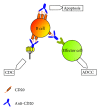B Cell in Autoimmune Diseases
- PMID: 23807906
- PMCID: PMC3692299
- DOI: 10.6064/2012/215308
B Cell in Autoimmune Diseases
Abstract
The role of B cells in autoimmune diseases involves different cellular functions, including the well-established secretion of autoantibodies, autoantigen presentation and ensuing reciprocal interactions with T cells, secretion of inflammatory cytokines, and the generation of ectopic germinal centers. Through these mechanisms B cells are involved both in autoimmune diseases that are traditionally viewed as antibody mediated and also in autoimmune diseases that are commonly classified as T cell mediated. This new understanding of the role of B cells opened up novel therapeutic options for the treatment of autoimmune diseases. This paper includes an overview of the different functions of B cells in autoimmunity; the involvement of B cells in systemic lupus erythematosus, rheumatoid arthritis, and type 1 diabetes; and current B-cell-based therapeutic treatments. We conclude with a discussion of novel therapies aimed at the selective targeting of pathogenic B cells.
Figures



Similar articles
-
B cell biology: implications for treatment of systemic lupus erythematosus.Lupus. 2013 Apr;22(4):342-9. doi: 10.1177/0961203312471576. Lupus. 2013. PMID: 23553777 Review.
-
Follicular helper T cells: new insights into mechanisms of autoimmune diseases.Ochsner J. 2013 Spring;13(1):131-9. Ochsner J. 2013. PMID: 23531878 Free PMC article.
-
Sialylated Autoantigen-Reactive IgG Antibodies Attenuate Disease Development in Autoimmune Mouse Models of Lupus Nephritis and Rheumatoid Arthritis.Front Immunol. 2018 Jun 6;9:1183. doi: 10.3389/fimmu.2018.01183. eCollection 2018. Front Immunol. 2018. PMID: 29928274 Free PMC article.
-
Therapeutics to block autoantibody initiation and propagation in systemic lupus erythematosus and rheumatoid arthritis.Sci Transl Med. 2015 Mar 25;7(280):280ps5. doi: 10.1126/scitranslmed.aaa3809. Sci Transl Med. 2015. PMID: 25810309 Review.
-
Selfie: Autoimmunity, boon or bane.J Immunoassay Immunochem. 2017;38(3):235-246. doi: 10.1080/15321819.2017.1319861. Epub 2017 Apr 19. J Immunoassay Immunochem. 2017. PMID: 28421864 Review.
Cited by
-
Mitochondrial Quality Control Orchestrates the Symphony of B Cells and Plays Critical Roles in B Cell-Related Diseases.J Immunol Res. 2024 Oct 17;2024:5577506. doi: 10.1155/2024/5577506. eCollection 2024. J Immunol Res. 2024. PMID: 39449998 Free PMC article. Review.
-
Peripheral memory B cells in multiple sclerosis vs. double negative B cells in neuromyelitis optica spectrum disorder: disease driving B cell subsets during CNS inflammation.Front Cell Neurosci. 2024 Feb 7;18:1337339. doi: 10.3389/fncel.2024.1337339. eCollection 2024. Front Cell Neurosci. 2024. PMID: 38385147 Free PMC article. Review.
-
Genetic mapping of cell type specificity for complex traits.Nat Commun. 2019 Jul 19;10(1):3222. doi: 10.1038/s41467-019-11181-1. Nat Commun. 2019. PMID: 31324783 Free PMC article.
-
B Cell and CD4 T Cell Interactions Promote Development of Atherosclerosis.Front Immunol. 2020 Jan 10;10:3046. doi: 10.3389/fimmu.2019.03046. eCollection 2019. Front Immunol. 2020. PMID: 31998318 Free PMC article.
-
Reconstruction of Cell-type-Specific Interactomes at Single-Cell Resolution.Cell Syst. 2019 Dec 18;9(6):559-568.e4. doi: 10.1016/j.cels.2019.10.007. Epub 2019 Nov 27. Cell Syst. 2019. PMID: 31786210 Free PMC article.
References
-
- Dandel M, Wallukat G, Potapov E, Hetzer R. Role of β1-adrenoceptor autoantibodies in the pathogenesis of dilated cardiomyopathy. Immunobiology. 2011;217(5):511–520. - PubMed
-
- Riemekasten G, Philippe A, Näther M, et al. Involvement of functional autoantibodies against vascular receptors in systemic sclerosis. Annals of the Rheumatic Diseases. 2011;70(3):530–536. - PubMed
Grants and funding
LinkOut - more resources
Full Text Sources
Other Literature Sources

